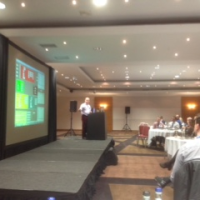 The first step in the process of improvement is raising awareness, and this has to be done carefully.
The first step in the process of improvement is raising awareness, and this has to be done carefully.
Most of us spend most of our time in a mental state called blissful ignorance. We are happily unaware of the problems, and of their solutions.
Some of us spend some of our time in a different mental state called denial.
And we enter that from yet another mental state called painful awareness.
By raising awareness we are deliberately nudging ourselves, and others, out of our comfort zones.
But suddenly moving from blissful ignorance to painful awareness is not a comfortable transition. It feels like a shock. We feel confused. We feel vulnerable. We feel frightened. And we have a choice: freeze, flee or fight.
Freeze is shock. We feel paralysed by the mismatch between rhetoric and reality.
Flee is denial. We run away from a new and uncomfortable reality.
Fight is anger. Directed first at others (blame) and then at ourselves (guilt).
It is this anger-passion that we must learn to channel and focus as determination to listen, learn and then lead.
The picture is of a recent awareness-raising event; it happened this week.
The audience is a group of NHS staff from across the depth and breadth of a health and social care system.
On the screen is the ‘Save the NHS Game’. It is an interactive, dynamic flow simulation of a whole health care system; and its purpose is educational. It is designed to illustrate the complex and counter-intuitive flow behaviour of a system of interdependent parts: primary care, an acute hospital, intermediate care, residential care, and so on.
We all became aware of a lot of unfamiliar concepts in a short space of time!
We all learned that a flow system can flip from calm to chaotic very quickly.
We all learned that a small change in one part of a system of interdependent parts can have a big effect in another part – either harmful or beneficial and often both.
We all learned that there is often a long time-lag between the change and the effect.
We all learned that we cannot reverse the effect just by reversing the change.
And we all learned that this high sensitivity to small changes is the result of the design of our system; i.e. our design.
Learning all that in one go was a bit of a shock! Especially the part where we realised that we had, unintentionally, created near perfect conditions for chaos to emerge. Oh dear!
Denial felt like a very reasonable option; as did blame and guilt.
What emerged was a collective sense of determination. “Let’s Do It!” captured the mood.
 The second step in the process of improvement is to show the door to the next phase of learning; the phase called ‘know how’.
The second step in the process of improvement is to show the door to the next phase of learning; the phase called ‘know how’.
This requires demonstrating that there is an another way out of the zone of painful awareness. An alternative to denial.
This is where how-to-diagnose-and-correct-the-design-flaws needs to be illustrated. A step-at-a-time.
And when that happens it feels like a light bulb has been switched on. What before was obscure and confusing suddenly becomes clear and understandable; and we say ‘Ah ha!’
So, if we deliberately raise awareness about a problem then, as leaders of change and improvement, we also have the responsibility to raise awareness about feasible solutions.
Because only then are we able to ask “Would we like to learn how to do this ourselves!”
And ‘Yes, please’ is what 68% of the people said after attending the awareness raising event. Only 15% said ‘No, thank you’ and only 17% abstained.
Raising awareness is the first step to improvement.
Choosing the path out of the pain towards knowledge is the second.
And taking the first step on that path is the third.
